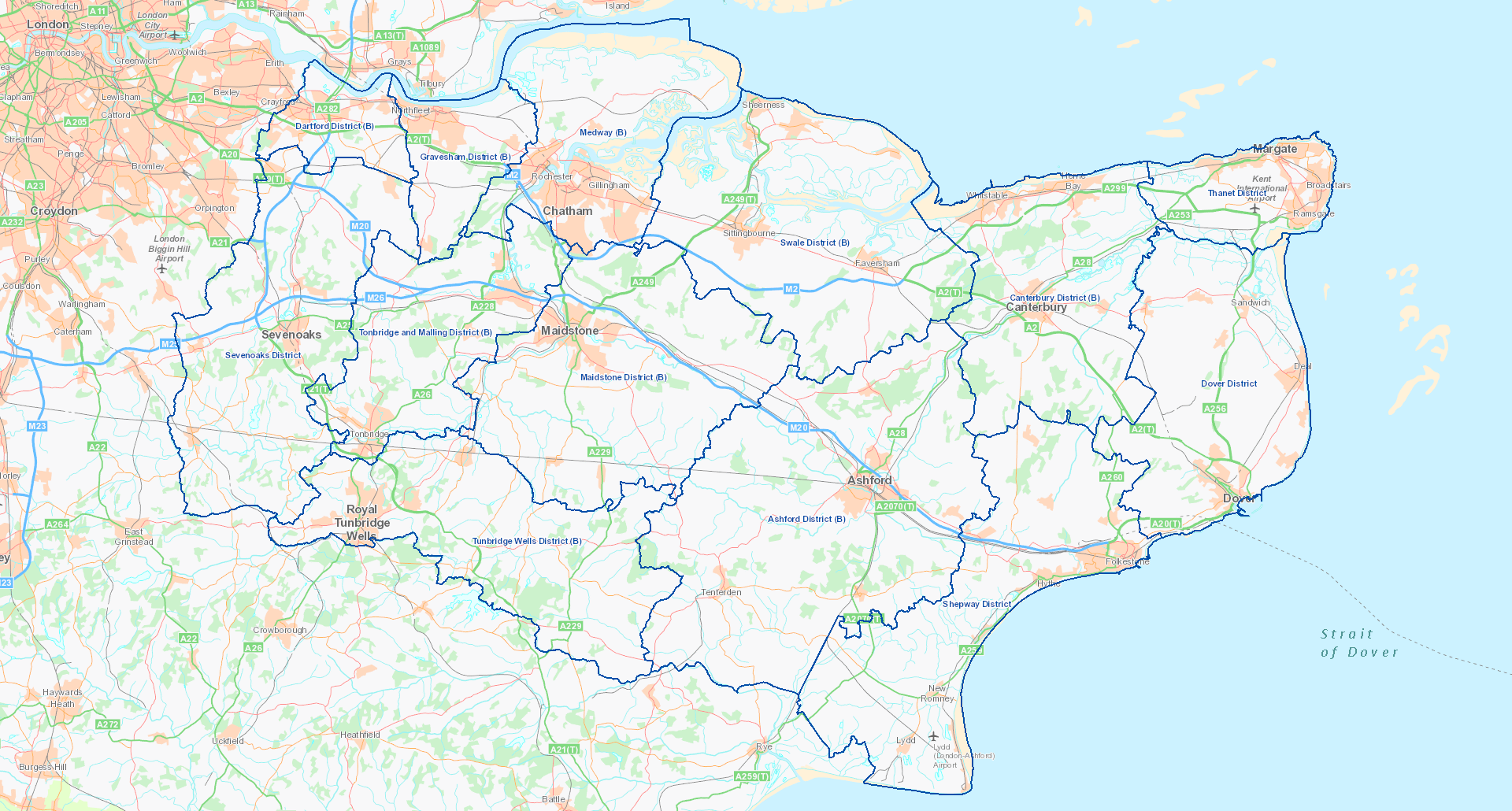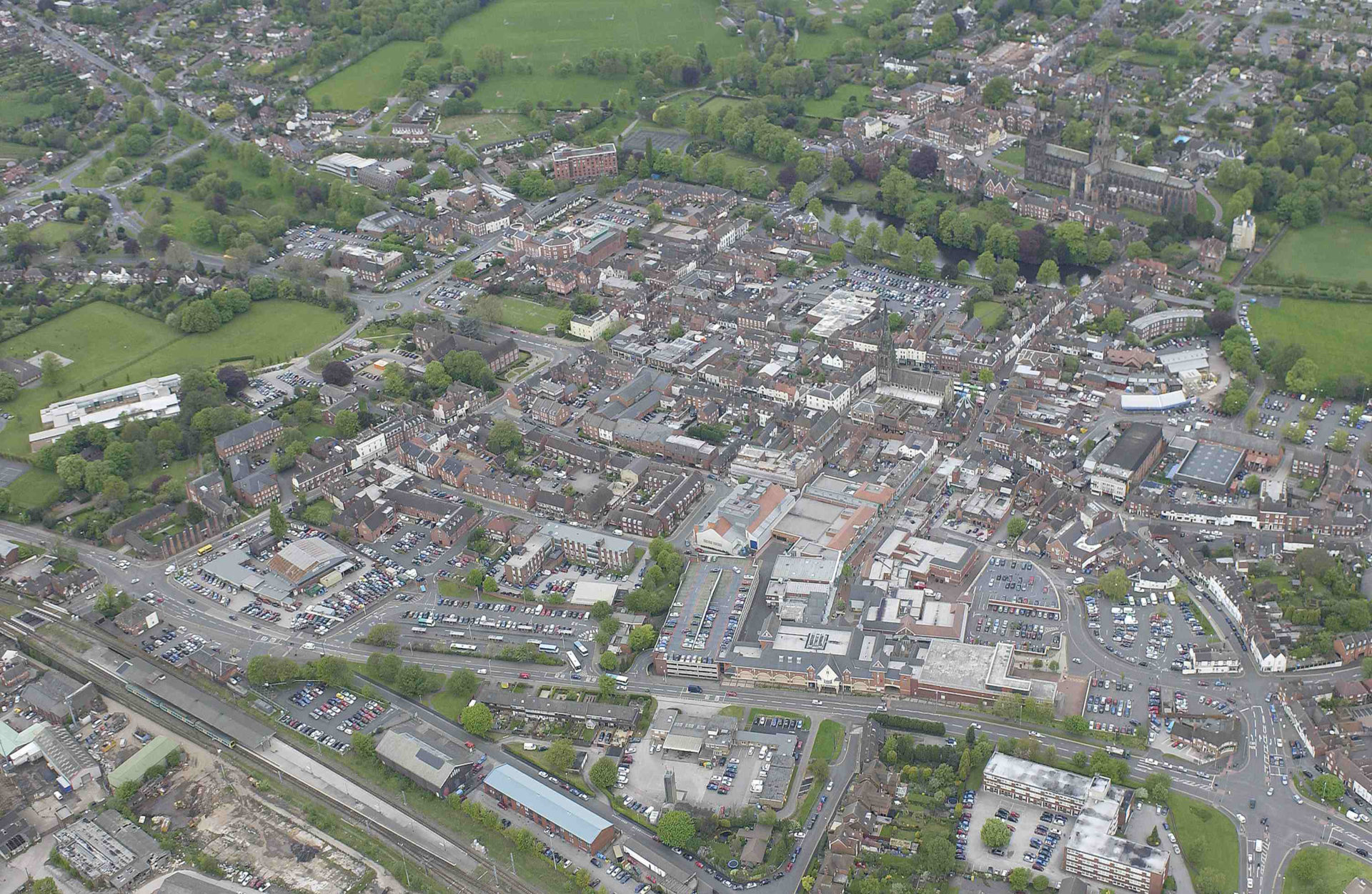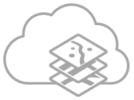Blog Archives
Post navigation

The Forestry Commission
The implementation of ArcGIS has enabled us to make cost savings in excess of £1 million a year from more efficient map production
The implementation of Esri’s ArcGIS platform has enabled The Forestry Commission to make cost savings in excess of £1 million a year from more efficient map production. Use of this enterprise-wide GIS also enables managers to make better informed decisions and publish visitor information for the general public more easily.
The Customer
The Forestry Commission protects and manages over a million hectares of land and 24,000 kilometres of roads across the UK, and researches innovative ways to use and care for Britain’s woodland.
It balances these tasks with commercial objectives, working with private landowners and national businesses, whilst producing approximately five million tonnes of wood each year for sale.
Employees can produce forestry maps from scratch 50% more quickly and update them 90% faster than before
61% of managers say that GIS has had a positive impact on the quality of their management decisions
GIS provides improved mechanisms for sharing information with the general public, partners and regulators
The Challenge
With apparently conflicting responsibilities, the Forestry Commission wanted to use GIS at the heart of its operations to bring its data together, improving forecasting and efficiency.
We are maximising the value of all Forestry Commission employees past and present to deliver the best possible service to citizens
Ben Ditchburn – Head of Forestry Information Systems
The Solution
Using a single database of spatially related data throughout the organisation, staff are connected and empowered to make strategic decisions about the land: forecasting timber production and forest development, protecting habitats, and helping people enjoy British woodland.
Esri has supported our GIS-based revolution in working practices every step of the way
Ben Ditchburn – Head of Forestry Information Systems
The Benefits
The partnership between The Forestry Commission and Esri UK has reaped many rewards over the years. “We were impressed by Esri’s working culture, which has always been about improving things in the long term,” says Ben Ditchburn, Head of Forestry Information Systems. “Esri has supported our GIS-based revolution in working practices every step of the way.”
Improved strategic decision making
The centralised geodatabase removes duplication and gives a shared view of operations. 61% of managers say GIS has had a positive impact on the quality of their management decisions, which are now based on hard facts. Sophisticated modelling and forecasting tools demonstrate the effects of decisions, “We can use GIS to predict the likely consequences of global warming on trees and how much carbon they can request, changes to grants or changes to the Common Agricultural Policy,” says Ditchburn. “We can then present evidence to the central government ministers responsible for decision making at the highest level.”
Improved services
Information about footpaths, picnic sites, biking trails etc is published online. “Once you have a central GIS data store with information relating to assets and activities, you can present it to members of the public quickly, transparently and cost-effectively,” says Ditchburn. Planning consultations are better informed too: “Because of GIS, the plans that our front line staff prepare and present look every bit as good as a professional architect’s drawings, which is fantastic for our credibility and selling our skills”, says Ditchburn.
Improved efficiency
A comprehensive electronic inventory of British woodlands “has reduced the time we spend drawing maps from scratch by 50% and enables us to update them 90% faster”, says Ditchburn, “delivering savings of more than £1 million every year”. Sophisticated GIS modelling shows how forests may change over time. “Our cartographers and landscape specialists could previously take a week or more to draw a single 3D landscape of the forest,” says Ditchburn. “Now, we can generate these images in a matter of minutes.”
Shared services
Service sharing is a key government objective, and because 80% of public sector data is spatially-related, GIS is an essential unifying force. For example, when trees need to be felled, the commission informs Natural England and the public, online, of temporary access restrictions. Ben Ditchburn estimates a manual process would be four times slower and that a bespoke system would have been hugely expensive, “Instead, we were able to start exchanging information electronically using our existing GIS system, spending just a fraction of this money on modifications.”
Demonstrating regulatory compliance
Compliance is increasingly complex, but GIS can be used to demonstrate adherence efficiently and professionally. Ben Ditchburn explains that “If you can logically describe and report on your assets, activities and plans for the future, you are in much stronger position to meet new regulations and directives.”
Improved business continuity
The cumulative experience of generations of employees is stored centrally for the benefit of colleagues, partners and citizens, now and in the future. It can be passed on more easily and appropriately than when it was held on paper or in people’s heads, helping new employees work effectively from day one.
Effective budgeting
Using inventory and GIS modelling, the Forestry Commission can estimate an area’s income from timber sales in minutes, rather up to eighteen man-months. Knowing likely income patterns “means we can set realistic targets for planting, conservation work and other operations and help minimise the cost of our activities for the tax payer”, says Ditchburn

The Forestry Commission Scotland
The new Land Information Search service makes it far easier for landowners and managers to maintain Scotland’s beautiful and invaluable rural environment
A new Land Information Search service has been launched in Scotland that helps landowners improve their management of the natural environment. Developed through the close collaboration of three public sector organisations, the online tool is expected to contribute to sustained cost savings through the closer collaboration of multiple government departments.
The Customer
This is a story about a successful collaboration between three Scottish public sector organisations working under the umbrella of Scotland’s Environment Web. The project was initiated by Forestry Commission Scotland, but could not have been achieved without with the input and commitment of its partners: Scottish Natural Heritage and Scottish Environment Protection Agency (SEPA).
Landowners can save time and complete more successful bids for woodland management grants
Government organisations can process funding applications more efficiently
The tool uses ArcGIS web services to stream up-to-date data directly from a variety of organisations
The Challenge
Across Scotland, a variety of grants are available to landowners to help them manage woodlands and plant new trees. However, in order to access this funding, individuals and groups have to complete formal applications, providing detailed information about their land, so that its suitability for planting can be fully assessed.
To assist landowners in this application process, Forestry Commission Scotland had previously developed a searchable database of land information. However, this application was now many years old and in urgent need of renovation. “We knew that we didn’t have the resources internally to update and redevelop our Land Information Search tool by ourselves, but we were very aware that it had the potential to deliver value to Scottish land managers right across the rural sector,” says Howard Davies, Geo-Information Services Delivery Manager at Forestry Commission Scotland. “We therefore approached our partners and proposed a collaborative project.”
All three organisations used the same GIS technology – Esri’s ArcGIS Platform – and it was this commonality that ultimately made it incredibly easy for the partners to collaborate on the creation of the new Land Information Search (LIS) tool
The Solution
Each of the three organisations involved brought a different, complementary skill or asset to the initiative. SEPA had secured funding from the European Commission LIFE+ funding programme and created the Scotland’s Environment web site to provide a ‘one stop shop’ for all information about the natural environment in Scotland. It therefore had the ideal launch pad for the rejuvenated data service and the necessary underlying technical infrastructure. Scottish Natural Heritage was able to provide skilled programmers to help develop the solution; and Forestry Commission Scotland had the customer knowledge and business knowledge to lead the project.
Significantly, all three organisations used the same geographic information system (GIS) technology – Esri’s ArcGIS Platform – and it was this commonality that ultimately made it incredibly easy for the partners to collaborate on the creation of the new Land Information Search (LIS) tool.
Now available for anyone to use on the Scotland’s Environment web site, the new LIS service provides landowners with a fast and convenient way to access a vast amount of information about their land and neighbouring areas. Users simply enter a postcode or a place name, or zoom into the interactive map to find the area they are interested in. Next, they mark a point on the map or draw a polygon around the specific fields or areas that they want to plant or maintain. The online tool then returns a detailed report on land findings, which users can either view online or download as a pdf file.
Developed using ArcGIS web services, the online tool works by streaming relevant, up to-date data directly from a wide variety of different organisations. Searches are currently performed against over 40 different data sets, ranging from recent woodland surveys and forestry boundaries to Sites of Special Scientific Interest and groundwater reports. If users click on the ‘more details’ button on their individually created search results reports, they are automatically directed to web sites with further information. So, for example, if an Iron Age burial mound is found near the search area, users can go directly to information about this scheduled monument on the Historic Scotland web site with just one click from their reports.
The new Land Information Search service delivers considerable benefits for landowners and managers, making it far easier for them to maintain Scotland’s beautiful and invaluable rural environment
Howard Davies – Geo-Information Services Delivery Manager, Forestry Commission Scotland
The Benefits
Through their collaboration, Forestry Commission Scotland, Scottish Natural Heritage and SEPA have succeeded in delivering a highly valuable and enhanced service for landowners. LIS currently attracts around 1,000 users per month, a figure that is expected to peak next year when new grant applications are invited for the next round of Scotland’s Rural Development Programme (SRDP).
For landowners applying for SRDP for example, the new LIS tool will save them an enormous amount of time. They will be able to find a great deal of the information they need to complete their funding applications in one place and have confidence that this data is up-to-date. “The new Land Information Search service delivers considerable benefits for landowners and managers, making it far easier for them to maintain Scotland’s beautiful and invaluable rural environment,” Davies says.
In tandem, the government organisations that administer rural funding applications will be able to operate more efficiently. It is anticipated that the quality of applications will be higher, saving time asking landowners to submit more information or pointing out information that materially impedes the feasibility of landowners’ plans. In the long term, these internal efficiency gains may translate into cost savings across multiple government organisations.
Although it was originally developed to support woodland management and tree planting, the LIS tool can now add value for a wide number of different users. Farmers and moorland managers for example, will now be able to use the service to access information pertinent to their development plans.
The remarkable thing about this project is that it is delivering exceptional benefits, but was created with minimal investment through the LIFE+ programme. Together, the three partners already had all the ArcGIS technology, skills, IT infrastructure and indeed, vision to build this valuable new public service. Davies claims: “It’s a great example of successful cross-government collaboration in Scotland.”

Hinckley & Bosworth Borough Council
By pushing customer insight out via the web, we are aiming to give our decision makers the information they need to deliver a better service to citizens.
Inspired by a presentation at one of Esri UK’s annual conferences, this rural borough council started to use Mosaic data with Esri’s ArcGIS Desktop solution to gain unprecedented insight into the 105,000 people living in its communities. The initiative has helped attract funding to the borough, save money and deliver an improved service for its citizens.
The Customer
Hinckley and Bosworth Borough Council provides local government services in rural south west Leicestershire, covering an area of 114.8 m2 and serving a population of 105,200. Its only towns are Hinckley, Earl Shilton and Market Bosworth.
The council used ArcGIS to perform analysis and complete a successful bid for £35,000 for youth cricket facilities
Improved information about elderly residents enables the council to help them claim benefits to which they are entitled
Around £18,000 of savings have been made from no longer using outside consultants for survey purposes
The Challenge
Geographic information systems (GIS) have been used at the council for many years, and in 2007, it undertook an internal audit of its GIS usage. “Two things came out of that audit”, explains Lee McMahon, land and property data manager. “First of all, we really needed to know more about the communities we served; and secondly we needed to be able to access this knowledge more easily.”
At an Esri UK conference, McMahon was inspired by a presentation about a London borough using Mosaic data with ArcGIS software. Developed by Experian, Mosaic categorises people and households using tightly defined classifications, based a variety of data sources. “What impressed me was how much information could be gained about communities and how this information had really driven major a transformation in a London borough.”
Mosaic gives us a new level of knowledge about our communities… By using this data in ArcGIS, we can highlight trends and uncover the root cause of issues
Lee McMahon – Land and Property Data Manager
The Solution
The council bought local Mosaic data to use with its suite of ArcGIS Desktop, maximising the benefit of the software it already had. The GIS team quickly and easily imported Mosaic data into ArcGIS and consolidated it with its own data and that of third parties, such as the Land Registry. Using the powerful analysis tools of ArcGIS, they built up a detailed picture of local communities:
New opportunities for young people
The English Cricket Board and the council jointly applied for funding to create youth sections of existing cricket clubs. Polygon analysis was used to identify homes within walking distance of clubs, and the communities within each catchment were analysed. “We could simply ask the question: ‘Where is the highest likelihood of 4-14 year olds with the highest indices of multiple deprivation?’”, says McMahon. The maps generated were used in a successful bid for £35,000 of lottery funding.
Supporting the elderly
The council was good at detecting fraudulent benefit claims, but suspected it was less effective at helping citizens who were not claiming benefits to which they were entitled, particularly pensioners. They created a hotspot map, cross referencing households already claiming benefits against over 65s with the highest indices of multiple deprivations. Using this data, they launched a targeted campaign, in association with Age Concern.
Tackling anti-social behaviour
Mosaic data has been combined with police data to profile areas where anti-social behaviour is a problem. McMahon says: “Our GIS analysis is revealing correlations between the reports of anti-social behaviour and the locations of specific groups in the community that have a tendency to feel vulnerable, such as elderly people living alone.” The council is taking steps to support and reassure vulnerable groups and work with the police to prevent antisocial behaviour in these areas.
By pushing customer insight out to everyone via the web, we are hoping to give all our decision makers the information they need to deliver a better service to citizens
Lee McMahon – Land and Property Data Manager
The Benefits
McMahon is enthusiastic: “Mosaic gives us a new level of knowledge about our communities”, he says. “By using this data in ArcGIS, we can highlight trends and uncover the root cause of issues.” Decisions are better informed because the council knows where to deliver services and to whom: “Experienced council employees knew our communities pretty well anyway, but now that insight is more accessible.”
Financial gains include a saving of around £18,000 from not using outside consultants to survey service needs, direct marketing savings because leaflets are targeted at relevant households, plus the £35,000 grant for youth cricket. Rapid analysis means “we accomplished the whole English Cricket Board funding project in just one day”, recalls McMahon.
Since the council increased its use of GIS and introduced Mosaic data, its rating has jumped from ‘fair’ to ‘excellent’. “While this achievement can be attributed to many things, our extended use of ArcGIS with Mosaic data is one of the factors that has enabled us to make better decisions and improve our overall performance”, McMahon believes.
LocalView Fusion is now extending the benefits of GIS. “By pushing customer insight out to everyone via the web, we are hoping to give all our decision makers the information they need to deliver a better service to citizens”, says McMahon. A citizen portal is planned, called ‘My Hinckley’, which will integrate with the back office and customer relationship management system. “You don’t need to be a web developer or GIS expert to use LocalView Fusion and can embed mapping into web pages very easily”, says McMahon.

Kent County Council
ArcGIS is used to facilitate the collection of biodiversity data, analyse survey findings and then publish information online.
GIS is playing a pivotal role in an EU-funded project to monitor and compare habitat changes in Kent and the Nord-Pas de Calais region of France. Different solutions from Esri’s ArcGIS is being used to facilitate the collection of biodiversity data, analyse survey findings and publish information in a format that is easy to access and understand.
ArcGIS has provided a robust and versatile platform for collecting, collating and analysing a massive three million polygons of habitats data from Kent alone
Using ArcGIS, Kent Council has been able to make its habitat survey findings easy to access and understand, in a variety of online formats
Environmental organisations and local authorities can use the GIS visualisations to inform and influence their conservation and development plans
The Project
The county of Kent in the UK and the Nord-Pas de Calais region of France share the same geological bedrock and consequently have similar woodland, chalk grassland and wetland habitats. With this common natural heritage, it made sense for the two regions to exchange information and expertise to improve the management of the landscape and the conservation of wildlife.
To facilitate this collaboration, an EU-funded project was launched called Assessing Regional Changes in Habitat (ARCH). This cross-border initiative aimed to improve the quality and consistency of habitats data in both regions and then make this data more accessible. On the Kent side of the English Channel, the ARCH project was led by Kent County Council and supported by partners including Kent Wildlife Trust, Kent & Medway Biological Records Centre, the Environment Agency and six district councils.
We were convinced that online interactive web maps would give us an effective and standard platform for exchanging knowledge with people in both the UK and France
William Moreno – Senior Biodiversity Projects Manager at Kent County Council
The Challenges
One initial concern was that the ARCH project would generate a vast amount of data. New survey methods meant that the volume of data collected would be far greater than that amassed ten years before in the 2003 Kent Habitats survey.
Another pivotal challenge was how to share the ARCH survey data with large numbers of organisations and individuals on both sides of the Channel – and ensure that the habitats data was easy for everyone to understand and use. Early in the project, the cross-border team concluded that maps were the answer. William Moreno, Senior Biodiversity Projects Manager at Kent County Council says: “We were convinced that online interactive web maps would give us an effective and standard platform for exchanging knowledge with people in both the UK and France.”
Because of the council’s legacy of using Esri GIS, we knew that we could trust it to handle the significant amount of data that would be generated by the ARCH project, and then publish it online
Peter Wain – Business Development Officer at KentGIS
The Solution
Kent County Council has a twenty-year history of using geographic information system (GIS) technology from Esri to capture, display and analyse information on digital maps. Indeed it had used Esri GIS for its previous habitat surveys. Peter Wain, Business Development Officer at KentGIS says: “Because of the council’s legacy of using Esri GIS, we knew that we could trust it to handle the significant amount of data that would be generated by the ARCH project, and then publish it online.”
Kent County Council used Esri’s ArcGIS Desktop solution and tablet computers to facilitate data collection in the field and then consolidated this field data with aerial and imagery. It analysed the survey data in Esri’s ArcGIS Desktop solution and published it via Esri’s ArcGIS Server solution in two ways. Firstly, using Esri UK’s LocalView Fusion product, the ARCH team made survey data available to experienced GIS users in a format they could navigate and interrogate. Secondly, the ARCH team developed specific maps, highlighting key findings, and published them using Esri’s ArcGIS Online. An online Map Portal hosted in ArcGIS Online was created which pulled all these web map applications and data services together.
In what was a critical aspect of the project, the ARCH team in Kent worked in parallel with partners in Calais to develop a common habitat classification system. As a result, all the data collected in the UK and France is directly comparable and presented in a standardised format on all ARCH maps, which facilitates comparative analysis.
GIS shows us more than just a snapshot in time; it enables us to make comparisons and show geographical and temporal change, and this insight is very valuable
Peter Wain – Business Development Officer at KentGIS
The Benefits
The suite of GIS solutions from Esri UK has provided Kent County Council with a robust and versatile platform for collecting, collating and analysing substantially more habitats information than ever before. For the 3,918 km2 Kent region alone, the ARCH team compiled a staggering 3 million polygons of data, compared to 160,000 polygons in 2003.
Esri’s GIS platform has added greatest value to the ARCH project by making biodiversity data highly accessible. Local authorities, environmental groups, research bodies, schools and individuals can visit a range of different web sites or the council’s LocalView portal to access interactive maps that help them truly understand habitats data. GIS-savvy organisations can also download the survey data via web-services and integrate it with their own business data to gain added insight into environmental and development issues.
Environmental organisations now have easy access to up-to-date habitats information that they can use to inform conservation work. For example, Kent Wildlife Trust is expected to use the GIS-based survey results to identify areas that are suitable for designation as Local Wildlife Sites. French organisations can also view the data from Kent and, thanks to the common classification system, they can make useful landscape and habitat comparisons.
In addition, land cover data has been derived from the habitat data and the GIS-based survey results are expected to deliver substantial benefits for development planning across Kent. The ARCH team has, for instance, developed an online map showing that developed land has increased by 62% over the last 50 years. “GIS helps us to provide evidence to policy makers about development and where land cover change has occurred within Kent,” says Wain. “GIS shows us more than just a snapshot in time; it enables us to make comparisons and show geographical and temporal change, and this insight is very valuable.”

Lichfield District Council
Everyone in the council can quickly obtain the information they need to do their jobs, which is particularly important in emergency situations such as flooding.
After using Esri’s ArcGIS platform to create a single repository for all of its spatial data, Lichfield District Council used Esri UK’s LocalView solution to make specific datasets easily accessible to teams via tailored portals on the council’s intranet. Employees can now more easily find precisely the information that they need to do their jobs and have complete confidence in the data’s accuracy
The Customer
Lichfield District Council is responsible for a population of around 97,000 people, 40% of whom live in rural areas. The district is over 331 km2 in size and sits within the county of Staffordshire in the West Midlands.
Everyone in the council can access the same, single source of up-to-date data, without worrying about different versions
Employees can quickly obtain the information they need to do their jobs, which is particularly important in emergency situations such as flooding
Information can easily be shared with partners in a controlled manner that restricts access to confidential data
The Challenge
Lichfield District Council had been using Esri GIS applications for many years. However, the lack of a central store of GIS data was becoming problematic. Council employees found it difficult to access data from other departments, with duplicate versions of the same datasets leading to inaccuracies and the potential for poor decision making.
When Gareth Thomas joined the council as the Corporate GIS Manager, he identified two priority goals; to create a single repository for all of the council’s spatial data, and to make it easier for people to access and use this data.
The potential of the solution quickly became very clear. People reacted very positively when they saw how easy it would be to access and view the data that they needed
Gareth Thomas – Corporate GIS Manager, Lichfield District Council
The Solution
Lichfield District Council selected Esri’s ArcSDE solution to provide it with the means to centrally store, update and manage its spatial data together with LocalView Intranet developed by Esri UK. LocalView Intranet is a browser-based application designed specifically for local authorities. It enables individuals and teams across departments to access a council’s central repository of spatially related information and maps, quickly and effortlessly.
Firstly Lichfield District Council implemented ArcSDE centralising the council’s disparate data resources and then it prepared a demonstration version of LocalView Intranet. “The potential of the solution quickly became very clear,” says Thomas. “People reacted very positively when they saw how easy it would be to access and view the data that they needed.”
LocalView Intranet was initially rolled out to a small number of users. The IT team customised the front end, loaded relevant spatial data and adapted the look and tasks available. “I have to admit it didn’t take us long,” recalls Thomas. “The reaction was very positive, and demand just snowballed from that point onwards.”
Now, the council has over six LocalView portals, each one customised to provide the data and tasks needed by departments or groups of users, as well as a corporate portal, with general data. Employees can access the solution from any computer in the office, on the road or at home.
Thomas explains: “We can tailor what users can do, as well as what users can see. We don’t have to clutter up the screen with lots of other things that they don’t need. At the same time we manage all the data files centrally, so the information is always the most accurate.”
We are now able to embed the use of spatial data into all aspects of our work, including emergency planning. The value that LocalView adds was clearly apparent in the aftermath of the floods
Gareth Thomas – Corporate GIS Manager, Lichfield District Council
The Benefits
All employees now access the same, single source of up-to-date information and use spatial data more extensively to support their day-to-day tasks. LocalView portals are developed quickly allowing the IT team to respond to short-term requirements, multi agency projects and emergency situations, using the skills they have in house.
The real benefits of LocalView were highlighted in 2007 when large areas within the council’s responsibility were affected by flooding. Data on the extent of the flooding was loaded into LocalView, providing everyone in the council with a clear view of the areas worst affected. This information was then used to plan the response effort. “LocalView has been a real success here,” says Thomas. “We are now able to embed the use of spatial data into all aspects of our work, including emergency planning. The value that LocalView adds was clearly apparent in the aftermath of the floods.”
Lichfield District Council also uses LocalView to provide external partners with access to its data, including Parish Councils and the Valuation Office. “Because this is an Intranetbased solution, we have greater control over access to the data,” explains Thomas. “We can limit the number of datasets our partners see and set up different portals, so that partners see only the data relevant for them. We can also restrict access to confidential data.”

London Borough of Hammersmith & Fulham
Staff across planning applications, highways maintenance and emergency planning use the ArcGIS platform to improve the quality of services for citizens.
Notable efficiency improvements have been achieved by the London Borough of Hammersmith and Fulham since it made GIS capabilities available to employees across the entire council. Users in departments such as parking, planning applications, highways maintenance and emergency planning all use Esri’s ArcGIS platform to improve the quality of services for citizens.
The Customer
The London Borough of Hammersmith and Fulham is responsible for an area of Greater London that is only 6.3 square miles, but contains over 180,000 residents, 105,000 properties, 1030 streets and 22,000 road signs. Geography is an important aspect of all this data, but was managed by different people on separate systems.
The enterprise-wide deployment of ArcGIS enables up to 1,250 concurrent users to produce as many as 200,000 maps every month
In the planning department, users can process around 3,000 planning applications more quickly than before using GIS
The environmental services department can handle enquiries more efficiently and plot trends to deliver better public services
The Challenge
Prior to 2000, Hammersmith and Fulham used a number of different Geographic Information Systems (GIS) and Computer Aided Design (CAD) drawing tools. While these solutions performed adequately, they only benefited specific individuals in single departments.
The borough therefore decided to develop and deliver an enterprise-wide GIS strategy, with the goal of establishing a corporate geographic information standard that could be used across the authority, making geographic information available to all 7000 employees – not just highly technical users – and incorporating GIS into a broad range of council activities and services.
“We recognised how GIS could help to modernise many processes, drive efficiency and improve service, but achieving this meant a total change in attitude towards GIS”, says Tina Dawson, GIS manager at H&F Bridge Partnership, working for the London Borough of Hammersmith and Fulham.
A formal review of the software available led to choosing Esri UK to supply the GIS solutions.
Our evaluation process showed that Esri’s was the only GIS platform capable of delivering enterprise-level scalability and use. Other solutions were departmentally focused and did not enable us to share geographic information across the council as effectively
Tina Dawson – GIS manager at H&F Bridge Partnership, working for the London Borough of Hammersmith and Fulham
The Solution
Esri UK helped Hammersmith and Fulham create a central database of spatial information, integrated with its land and property gazetteer. Employees were given intranet access to the data and a broad range of mapping capabilities, via a browser. This provides easy access to accurate data ranging from planning applications to street furniture. Sensitive data is handled via a secure, password-controlled mapping resource.
The next stage was to give residents access to geographic data via online applications, e.g. for locating council services.
Today, the geodatabase holds around 100 gigabytes of data and supports up to 1,250 concurrent users. As many as 200,000 maps are generated every month and this figure continues to increase.
“Our evaluation process showed that Esri’s was the only GIS platform capable of delivering enterprise-level scalability and use. Other solutions were departmentally focused and did not enable us to share geographic information across the council as effectively”, said Tina Dawson.
GIS plays a key role in all aspects of environmental services, not only in the detailed plotting of trends, but also in the improvement of day-to-day processes, enabling a better service to the borough’s citizens
Nigel Pallace – Director of the Environment Services Department
The Benefits
All Hammersmith and Fulham staff benefit from the undisputed success of enterprise-wide GIS – from the chief executive to planning officers and call centre agents, seamlessly sharing information across departments:
Parking suspensions and skip licences: It is easy for staff in the Planning Department and Highways Department to check each other’s records to ensure that requests are granted or denied promptly and appropriately.
Planning applications: Faster processing of around 3,000 planning applications and thousands more enquiries per year.
Highways maintenance: The GIS stores the precise location and state of repair of assets on multilevel, interactive maps, enabling strategic maintenance planning.
Emergency planning: CCTV camera sites, hospitals, electricity sub stations and potential evacuation centres etc are mapped and stored for rapid despatch to emergency services.
Environment enquiries: Call centre operators can quickly zoom to specific streets and addresses to pinpoint the location of a problem and contact the most relevant person to handle it.
Many parts of the council simply couldn’t operate without GIS now, and H&F Bridge Partnership’s aim is to integrate it with all business processes within the council… We want to put GIS at the heart of everything we do
Tina Dawson – GIS manager at H&F Bridge Partnership, working for the London Borough of Hammersmith and Fulham
The Future
Hammersmith and Fulham’s online interactive map for residents was a finalist in the GIS section of the 2005 European Information Management Awards, and a project to enable residents to view street works on the internet was nominated for the Society of IT Managers (SOCITM) e government successes database.
This level of success means that the borough plans to keep on expanding its use of corporate GIS until it underpins the work of every department. “GIS is now recognised as a key component of our business systems” says Dawson. “Many parts of the council simply couldn’t operate without GIS now, and H&F Bridge Partnership’s aim is to integrate it with all business processes within the council… We want to put GIS at the heart of everything we do,” concludes Dawson.
” Further benefits come from the creation of H&F Bridge Partnership: a Joint Venture Company (JVC) between the borough and Agilisys. This partnership plans to run training courses for staff and will work with departments that use GIS minimally to identify how it might help improve service delivery. It also plans to make GIS data available to local schools and share emergency planning GIS data with neighbouring boroughs, eventually creating a comprehensive map-based resource that could be used in the event of a major incident in London.

London Borough of Harrow
Having attended a three-day Esri training course, I was able to develop a new application from scratch, saving the council thousands of pounds.
Faced with an urgent requirement to update an aging GIS solution, an employee from Harrow Council took the ambitious decision to redevelop this critical application, himself, in-house. To gain the skills and knowledge required, he attended a training course delivered by Esri UK after which he was able to create, maintain and further develop a Python-based solution, saving the council thousands of pounds.
The Customer
Harrow is a London Borough in the North West of the capital, bordering Hertfordshire. The London Borough of Harrow Council serves a population of over 230,000 people across an urban area of 50.47 km2.
The three-day training course delivered by Esri UK enabled one council employee to develop the new application, from scratch, in days
The council cancelled plans to hire a contractor to develop the solution, making a significant financial saving
The training materials continue to act as a useful resource, helping the council to continue to develop the solution to support new council services
The Challenge
Over a period of years, Harrow Council has developed a suite of web-based services for citizens that are powered by geographic information system (GIS) technology from Esri UK. These online GIS services allow people to register for council tax or report fly tipping, for example, by verifying locations on digital maps. The council also uses Esri GIS software to deliver its ‘MyHarrow’ application, which enables citizens to use online maps and location based services to easily find their nearest library or school and check bin collection days or see who their Councillors are.
At the back-end of all these online GIS services lies a small but vital GIS integration application. This solution had been developed several years ago by a third party to extract data from the council’s Local Land and Property Gazetteer (LLPG), enrich it and present it on demand as a core part of its web based GIS services. Without the LLPG Integrator application, MyHarrow and the council’s other web-based GIS services would grind to a halt.
The LLPG Integrator was in urgent need of updating as it was no longer fully compatible with the latest format for LLPG data. Unfortunately, however, the council did not have the skills or knowledge to develop it in-house. Rather than engaging a contractor to modify the solution, LLPG custodian Luke Studden decided that the time had come to replace it with a new integration solution that he could manage and develop himself.
We see Esri UK as the market leader for all things GIS
Luke Studden – LLPG custodian, London Borough of Harrow
The Solution
Harrow Council had been using Esri ArcGIS software for several years and instinctively turned to Esri UK for advice. “We see Esri UK as the market leader for all things GIS,” Studden says.
After speaking with experts from Esri UK, Studden decided to develop a new LLPG Integrator solution using Esri ArcGIS software and the programming language Python. Having never used Python before, he signed up for Esri UK’s three day course entitled ‘Introduction to geoprocessing scripts using Python’. “The course was extremely comprehensive,” he says. “It covered all the basics, but also enabled me to develop some quite advanced skills. By the end of the three days, I had all the knowledge I needed to go away and re-develop the council’s LLPG Integrator solution myself.”
Studden particularly appreciated the depth and breadth of the course materials supplied. “The training manual sits on my desk and I refer to it frequently,” he says. “It’s a good companion for programming in Python.”
The course was extremely comprehensive. It covered all the basics, but also enabled me to develop some quite advanced skills. By the end of the two days, I had all the knowledge I needed to go away and re-develop the council’s LLPG integrator myself
Luke Studden – LLPG custodian, London Borough of Harrow
The Benefits
Within days of completing Esri UK’s training, Studden had successfully redeveloped the council’s LLPG Integrator from scratch, using ArcGIS technology and Python. By creating this solution himself – and not outsourcing the project to a third party contractor – Studden saved the council a significant sum of money, which could potentially have run into many thousands of pounds. The investment in training from Esri UK therefore represented exceptional value for money.
The new LLPG Integrator solution has now been up-and-running at the council for over a year and delivers consistently good performance. Unlike its predecessor, this GIS solution can be easily adapted by the council, as required, to reflect new versions of the LLPG or changes in council services. “We can extend it, modify it and enhance it whenever we want to,” Studden says.
Recently, Studden adapted the LLPG Integrator to enable users of MyHarrow to view environmental information pertaining to their streets and neighbourhoods, such as flood risks. This new capability was introduced in less than two hours of Python programming. Esri UK’s training course has therefore furnished the council with the skills it needs to continue to develop new services for citizens.
The new LLPG Integrator is robust and adaptable enough to support the delivery of online GIS solutions for many years to come – and this is a key advantage for the council. MyHarrow and other online GIS services are strategically and operationally very important because they help the council to deliver more flexible and accessible services for citizens. At the same time the online GIS services enable the council to reduce the cost of customer contact by eliminating the need for more expensive face-to-face and telephone enquiries.

Garsdale Design
CityEngine is transformational. We can quickly produce and amend 3D plans, delivering an efficient and top-quality service for our clients
From a converted barn in Cumbria, a small family-run design business is producing highly professional 3D urban models for the redevelopment of war-torn Iraqi cities. Thanks to the use of Esri’s CityEngine solution, Garsdale Design can quickly produce and amend 3D plans, delivering an efficient, top-quality service for its Middle Eastern clients.
The Customer
Garsdale Design is an architecture, urban design and planning firm, operating from offices in a converted barn in Cumbria. While its location may be rural, its business is undeniably global. The firm has extensive experience of undertaking urban design and city master planning assignments in the Gulf Arab states and Middle East.
The time required to produce a 3D model of a new building has been cut from four days to just half a day
The business can make last minute changes to models, very quickly, thereby meeting deadlines without having to pay outside contractors for help
The 3D models help the firm’s clients to understand what cities may look like in the future, to help make more informed planning decisions
The Challenge
Along with its Iraqi partners, Garsdale Design has been contracted by the Ministry of Municipalities and Public Works in Iraq to create urban plans for the reconstruction of several key cities in the country. This long-term project involves planning for new homes, infrastructure, transport, sewerage, water and electric systems in areas that have been seriously damaged by many years of war and neglect.
Garsdale Design recognised the importance of 3D modelling in urban planning and aspired to provide 3D visualisations of its plans to help its Iraqi clients and partners understand proposed developments. However, creating these 3D models was very time-consuming. The firm used to sketch proposed new buildings, streets and squares by hand and then digitise the pictures to create 3D images. Unsurprisingly, it used to take around four days to produce a 3D model of a single building, such as a new neighbourhood centre.
As is common in large urban redevelopments, unexpected changes were a regular occurrence. On one occasion, the location of a bridge was altered without warning, which had obvious ramifications for the planned road network and neighbouring buildings. When changes like this occurred, the firm had to throw away its out-of-date 3D models and start again from scratch – and if deadlines were tight, the firm had to make a difficult choice between not providing 3D visualisations or paying for someone else to create them.
CityEngine has expanded what we can achieve and deliver to our clients in short timescales. It helps us to keep up with bigger design companies and provide a professional service for our clients
Elliot Hartley – Director, Garsdale Design
The Solution
The discovery of Esri’s CityEngine solution has had a profound impact on the way that Garsdale Design works. 3D models have been transformed from a peripheral offering for clients into a core part of the company’s master planning process.
CityEngine is fully integrated with Esri’s ArcGIS platform and converts two-dimensional geographic information system (GIS) data into 3D models in a series of simple steps. It includes a 3D editor tool for creating realistic facades and adding vegetation and street furniture, all of which enables users to produce clear and realistic models. Despite the word ‘city’ in its name, CityEngine can be equally valuable in developing 3D models of rural landscapes, small developments and wind farms, for example.
Models or ‘scenes’ created in CityEngine can be easily published on the Internet and shared with colleagues, clients and partners. Esri’s Web Scenes viewer allows users to develop two models side by side and then employ a swipe tool to see what a development might look like, before and after.
CityEngine is transformational. It has enabled us to make dramatic time savings and, for our business, raised our ambitions so we are inspired to re-evaluate processes we took for granted
Elliot Hartley – Director, Garsdale Design
The Benefits
Through the use of CityEngine, Garsdale Design is now able to produce accurate 3D visualisations of how cities might look in the future, far more easily. These models help its clients to understand the available planning options and make better decisions to improve the lives of hundreds of thousands of city residents.
Whereas it used to take Garsdale Design around four days to create a model of just one building, the firm can now create 3D visualisations of entire city quarters in just half a day. Furthermore, when last minute changes occur or new information is received from Iraq, Garsdale Design can update its existing 3D visualisations quickly, without having to start again from scratch.
These time savings mean that Garsdale Design can now deliver a larger number of top quality, up-to-date 3D visualisations for its clients. The firm saves money by not having to pay for outside help to meet project deadlines and delivers a higher standard of service for its clients.
Elliot Hartley, director of Garsdale Design, says: “We’re a small family firm and don’t have lots of people and departments that we can draw upon when we have tight deadlines. CityEngine has expanded what we can achieve and deliver to our clients in short timescales. It helps us to keep up with bigger design companies and provide a professional service for our clients.”
In the future, Garsdale Design intends to embed rules into its 3D models, so that when data layers are added or changed, the master plan automatically updates the area. For example, if solar data is added, CityEngine could remodel a planned housing development to orientate roofs to the best angle to optimise solar energy generation.
Summing up, Hartley says: “CityEngine is transformational. It has enabled us to make dramatic time savings and, for our business, raised our ambitions so we are inspired to re-evaluate processes we took for granted. We are doing things now that we didn’t think possible before.”

Homes in Havering
Mobile GIS has halved the time required to complete property inspections, creating a more efficient process and ultimately, improved resident satisfaction
Use of a mobile GIS solution from Esri UK enables Homes in Havering to deliver more efficient and effective services for the residents of over 10,400 homes in East London. Employees use Esri’s ArcPad on tablets to halve the time required to complete property inspections, instigate maintenance tasks more quickly and improve the quality of business data.
The Customer
Homes in Havering (HiH) was formed in July 2006 as an arms-length management organisation (ALMO) working on behalf of the London Borough of Havering. It is responsible for managing 10,411 tenanted homes, 2,207 leasehold properties and 2,830 garage units in East London.
Mobile employees can undertake property inspections and other reports 50% more quickly than before
Residents benefit from faster resolution of maintenance issues, which improves their satisfaction and quality of life
ArcPad has created more efficient processes across the business and led to improvements in the quality and timeliness of business data
The Challenge
As a not-for-profit organisation, HiH aims to operate as cost efficiently as possible, reinvesting income to create homes and communities that residents can take pride in. At the time, staff carried out surveys of estates by filling in paperwork by hand, then typing them up when they got back to the office or sending them off to be manually transferred into an electronic format. “By the time that the information was available in our central systems, it was often out-of-date,” explains Roy Ojelade, Estates Services Manager at HiH. “Our processes were slow and disjointed.”
There were other challenges too. When staff went out on site, they sometimes found it hard to determine if pieces of land were the responsibility of HiH or other organisations. Consequently, it wasn’t uncommon for a lot of effort to go into dealing with issues that were not HiH’s responsibility. In addition, staff often found it hard to describe exactly where issues were on an estate. As a result, contractors and maintenance teams sometimes wasted time because they couldn’t find the locations mentioned in reports. All of these issues meant that residents didn’t always receive a prompt and effective service.
Tasks that used to take our mobile staff considerable time are now done more efficiently with any data collected being available to be disseminated among other departments within the organisation
Roy Ojelade – Estate Services Manager at Homes in Havering
The Solution
Soon after its foundation, HiH took the bold decision to extend and develop its mobile working strategy, believing this approach would improve operational efficiency, increase the visibility of staff on estates and provide a better service for residents.
Esri’s ArcPad mobile Geographic Information System (GIS) software was deployed on lightweight, portable computers to 35 employees including 12 neighbourhood wardens, 16 tenancy and neighbourhood officers, 3 senior estate managers and 4 caretakers. Through the use of ArcPad, these mobile employees can access detailed maps of each of HiH’s properties while on site and attach a precise location references to their electronic property report.
Mobile GIS is now firmly embedded into the organisation’s processes, if an area of grass has not been cut, mobile workers can see if it is the responsibility of HiH or another organisation. If a tree requires any work, they can direct the contractor straight to the exact tree at any location. Ojelade says: “We use ArcPad for just about everything, whether checking a tree for storm damage, conducting a routine estate inspection or reporting a pothole in a path.”
ArcPad helps to ensure that the data collected is geographically accurate and consistent, so it can be used for comparison and analysis. It eliminates the paper trail and improves the overall efficiency of our teams
The Benefits
More efficient business processes
The use of ArcPad has helped HiH to develop a more efficient and standardised processes, generating better data across the business. “ArcPad helps to ensure that the data collected is geographically accurate and consistent, so it can be used for comparison and analysis,” says Pluck. “It eliminates the paper trail and improves the overall efficiency of our teams.”
Time savings of at least 50%
HiH estimates that its mobile solution has reduced the amount of time required for completing inspections and other reports by at least fifty per cent. Ojelade says: “Tasks that used to take our mobile staff considerable time are now done more efficiently with any data collected being available to be disseminated among other departments within the organisation.”
Greater information sharing with residents
Caretakers use ArcPad to record the precise location where bulk rubbish, such as old mattresses and broken furniture, is found. This information is then uploaded from the mobile devices to HiH’s central systems, where it is then compiled into monthly reports and published online. “The data collected allows us to re-charge residents for bulk rubbish with precise information about what has been dumped and where,” explains Ojelade. “ArcPad provides a fast and accurate way for us to collect this information.”
Improved maintenance of properties
Mobile teams can quickly report faults and issues which means these problems can be rectified more quickly too. Likewise, staff can identify where contractors are failing to meet standards and point out areas that need greater attention with more precision. The use of ArcPad has enabled HiH mobile working strategy, delivering a more streamlined process in the overall maintenance of HiH’s estates and to a corresponding improvement in resident satisfaction.

Manchester Airport Group
By analysing patterns of movement around the airport we can understand the changing needs of our customers and target resources appropriately
The enterprise-wide use of Esri’s ArcGIS platform has brought clarity to complex operational, environmental and strategic issues at Manchester Airport (MAG). The solution has helped the organisation to optimise retail profitability, improve the efficiency of its workforce and make better decisions about the future development of the UK’s third busiest airport.
The Customer
Manchester Airports Group (MAG) owns and operates four British airports: Manchester, London Stansted, East Midlands and Bournemouth. As the largest UK-owned airport business, it serves around 42 million passengers every year and supports more than 130,000 jobs.
MAG used ArcGIS to analyse patterns of movement around the airport and optimise office locations to improve the efficiency of its workforce
ArcGIS was used to analyse passenger footfall in retail areas and increase revenues from retail units, while decreasing marketing costs
Engineers use ArcGIS to better plan maintenance activities so as to minimise disruption to flights and passengers
The Challenge
Known as ‘the global gateway to the North of England’, Manchester Airport is the largest of MAG’s four regional airports. MAG wanted to increase the profitability of this successful passenger and freight transportation hub, by maximising its retail revenues, improving its marketing to new and existing customers and optimising its efficiency across all areas of the business.
In any organisation, these would be ambitious goals. In a complex business like Manchester Airport, however, the challenges are multiplied. As well as developing its business, MAG must simultaneously address a multitude of other issues including environmental legislation, aviation safety, airport security and the sensitivities of local residents.
ArcGIS has been instrumental in helping MAG minimise its impact on the environment, improve its customer service and develop positive community relations
The Solution
Geographic information system (GIS) technology was first used at Manchester Airport nearly 20 years ago, when it was employed to model noise contours. Following early success with the technology, the use of GIS steadily expanded and, today, it is a vital spatial information management and business analysis system, employed to great effect throughout the entire organisation. MAG’s enterprise GIS platform is based on Esri’s ArcGIS technology and encompasses server, desktop and mobile applications.
Our use of GIS helped us create a more efficient workforce
Vickie Withnell – Group GIS Advisor, MAG
The Benefits
ArcGIS brings clarity to complex operational, environmental and strategic issues and, over recent years, has played a pivotal role in helping MAG make important decisions about the development of Manchester Airport. The solution has identified opportunities to improve business efficiency and hence reduce costs, as well as revealed new ways to optimise profitability. ArcGIS has also been instrumental in helping MAG minimise its impact on the environment, improve its customer service and develop positive community relations.
Here are just a few examples of how GIS has added immeasurable value for MAG.
In one very successful initiative, the organisation employed GIS to analyse the locations of its assets at Manchester Airport vis-à-vis the locations of the people who use those assets on a daily basis. It then relocated teams to site them in better facilities in more convenient areas, where they would spend less time travelling to and from jobs. “Our use of GIS helped us create a more efficient workforce,” says Vickie Withnell, Group GIS Advisor at MAG. “At the same time, we managed to free up office space that could be allocated to commercial, thereby improving our profitability.”
During the renovation of its departure areas, MAG employed GIS to model the new retail spaces created and demonstrate passenger flow through these areas. With this valuable insight, the retail team could identify the retail units with the highest ‘footfall’ and market these premium units to higher-end retailers. MAG was able to optimise its retail revenues, as well as make cost savings by re-using the GIS visualisations for brochure illustrations.
Engineers at MAG use a mobile GIS application to log faults and request maintenance work while out and about on site. MAG then analyses this information and uses it to plan work strategically, taking into account aircraft departure and arrival times. “We can now schedule work to suit the business and minimise disruption to our airline customers at busy times,” Withnell says.
To improve the customer experience, MAG used GIS to visualise and analyse customer locations, socio-demographic groups, methods of travel to the airport, road and rail networks and car parking facilities. With this information, it could then target its marketing more precisely, sending information about train stations to potential customers in the areas where people most commonly travel via train and sending information about the most conveniently-located car parks to the people who travel by car. MAG saved money on its marketing, while delivering relevant information to customers that will improve the quality of their visit to the airport.
MAG’s community relations team used GIS to analyse flight paths, noise contours and residential areas and identify the individual properties that qualified for funding for secondary double glazing under the Sound Insulation Grant Scheme. “It was a positive exercise in community relations that resulted in over 2,000 grants being awarded to local people,” Withnell says.
Building on its many successes, MAG is now developing a new GIS, based on ArcGIS, to help it undertake long term asset planning. This advanced solution will simplify the entire asset management lifecycle and play a critical role in helping to shape the future growth of the organisation.


